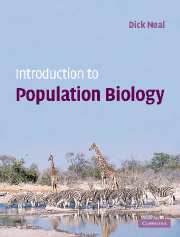Book contents
- Frontmatter
- Contents
- Preface
- Acknowledgements
- PART I Evolution by natural selection
- PART II Simple population growth models and their simulation
- PART III Population genetics and evolution
- PART IV Demography
- PART V Interactions between species, and the behaviour of individuals
- Chapter 17 Interspecific competition and amensalism
- Chapter 18 Predation
- Chapter 19 Animal behaviour, natural selection and altruistic traits
- Chapter 20 Sexual selection and mating systems
- Chapter 21 Epilogue
- Glossary
- Solutions to problems
- References
- Index
Chapter 20 - Sexual selection and mating systems
- Frontmatter
- Contents
- Preface
- Acknowledgements
- PART I Evolution by natural selection
- PART II Simple population growth models and their simulation
- PART III Population genetics and evolution
- PART IV Demography
- PART V Interactions between species, and the behaviour of individuals
- Chapter 17 Interspecific competition and amensalism
- Chapter 18 Predation
- Chapter 19 Animal behaviour, natural selection and altruistic traits
- Chapter 20 Sexual selection and mating systems
- Chapter 21 Epilogue
- Glossary
- Solutions to problems
- References
- Index
Summary
In addition to his theory of natural selection, Darwin also proposed a theory of sexual selection to account for certain types of sexual dimorphism (Darwin 1859). He was trying to explain the evolution of secondary sexual characteristics, like the tail of the peacock. The huge ornamental tail in this species appears to be maladaptive, in the sense that it increases the chances of the individual being eaten by a predator by making it harder for the males to fly away, and so is not readily explained by the theory of natural selection. Darwin went on to develop his theory of sexual selection more fully in one of his later books, The Descent of Man and Selection in Relation to Sex (1871).
In this chapter we will look at the basic reasons for sexual competition, go on to consider sexual selection, and finally make a brief survey of some of the different types of mating systems in animals. In a sense, we are completing a circle. We started this book by looking at Darwin's theory of natural selection, and we will end it by looking at a particular type of selection, namely sexual selection.
Sexual conflict and competition
In sexual reproduction, the interests of males and females may conflict with one another. There may also be competition within members of one sex for the reproductive services of the other. The seeds of this conflict and competition lie in the evolution of anisogamy.
- Type
- Chapter
- Information
- Introduction to Population Biology , pp. 336 - 353Publisher: Cambridge University PressPrint publication year: 2003



